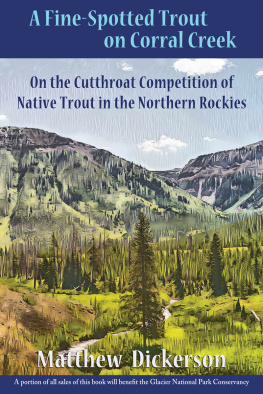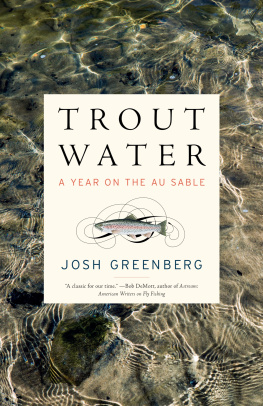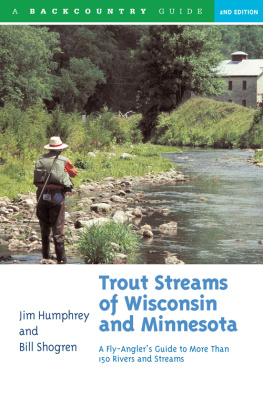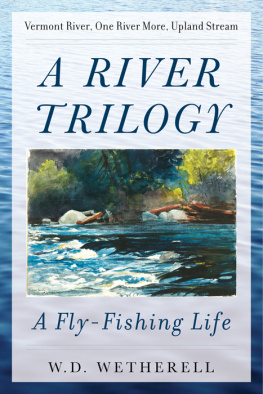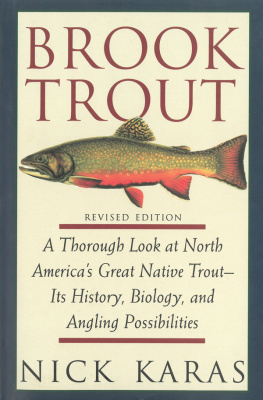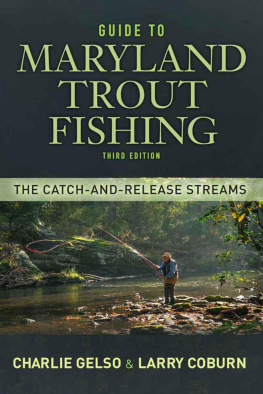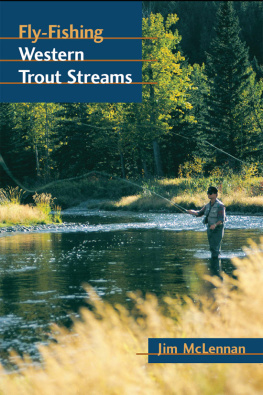Matthew Dickerson takes his readers from an Applachian trout stream in western North Carolinawhere wild trout are reduced to sipping cigarette buttsup to his home state of Vermont, where development and the ski industry threaten the states iconic pastoral riversides. Fnally he heads into western Maine to a once-dead river that has returned to life. Along the way, the author shares stories of both loss and hope through the eyes of a fly fisherman chasing wild trout. This lovingly described journey brings us through Dickersons own life of discovery and his love of fly fishing, trout, and the rivers where trout live. Though neither an historical nor a scientific text, the writing is informed by both. Readers will gain an understanding of both stream ecology and the history of human habitation and consumptionalong with getting a grand fishing tale. A Tale of Three Rivers is illustrated with original woodcuts by Vermont artist Courtney Allenson.
A Tale of Three Rivers: Of Wooly Buggers, Bowling Balls, Cigarette Butts, and the Future of Appalachian Brook Trout
2018 by Matthew Dickerson
Woodcut illustrations 2018 by Courtney Allenson
First Edition
Print Edition ISBN: 978-1-60940-457-4
ePub ISBN: 978-1-60940-458-1
Kindle ISBN: 978-1-60940-459-8
PDF ISBN: 978-1-60940-460-4
Wings Press
627 E. Guenther San Antonio, Texas 78210
On-line catalogue and ordering:
www.wingspress.com
All Wings Press titles are distributed to the trade by Independent Publishers Group www.ipgbook.com
Library of Congress Cataloging-in-Publication Data:
Names: Dickerson, Matthew T., 1963- author. | Allenson, Courtney, illustrator.
Title: A tale of three rivers : of wooly buggers, bowling balls, cigarette butts, and the future of Appalachian brook trout / Matthew Dickerson ; illustrations by Courtney Allenson.
Description: First edition. | San Antonio, Texas : Wings Press, 2018. | Series: Heartstreams ; vol. II
Identifiers: LCCN 2018010668| ISBN 9781609404574 (trade pbk. : alk. paper) | ISBN 9781609404598 (mobi pocket/kindle) | ISBN 9781609404604 (pdf )
Subjects: LCSH: Brook trout fishing--New England--Anecdotes. | Fly fishing--New England--Anecdotes. | Dickerson, Matthew T., 1963
Classification: LCC SH689.3 . D53 2018 | DDC 799.17/554--dc23
LC record available at https://lccn.loc.gov/2018010668
Contents
Prologue:
Brook Trout, Appalachia, and Story
T his book tells a story. Since I am the narrator and one of the characters, it is something of my own story. Fortunately for readers, however, I am not the primary character. I dont claim that my own life is interesting; I have no plans to write a memoir, and if I did I dont imagine anybody would buy it. But the interesting parts of my story involve rivers and trout. And those riverslike the generations of fish that have inhabited themhave tales that are much longer and more interesting than my own. Which is to say, in the story I am telling here, these rivers are the interesting characters.
Chief among them is Maines Androscoggin River. I have spent considerable time in, on, and around the Androscoggin watershed over the past four and a half decades, hiking, driving, camping, picnicking, and canoeing. And, of course, fly fishing. I shared some of the story of that river in an earlier and longer book, Downstream: Reflections on Brook Trout, Fly-Fishing, and the Waters ofAppalachia, co-authored with my friend David OHara. But that was only a small part of a long and beautiful story. Though I learn more of the story each yearand each new bit I learn leaves me fascinated to discover morethe Androscoggins story is too vast and complex for me to claim to know but the tiniest fragment of it. The third and final chapter of this book provides just a glimpse into that story. The tale of that river and its headwaters and tributaries in the mountains of western Maine and northeastern New Hampshire is a hopeful one. Or at least its current chapter is hopefulparticularly the portion that takes place since 1980 in the river upstream of Bethel. It is a chapter that, for me at least, speaks hope for all of Appalachia.
It is not only in the continued healthy presence of a wild native strain of s. fontinalis, uncontaminated by stocked fish, in the headwaters of the Androscoggin (in rivers like the Magalloway, Rapid, Cupsuptic, and Kennebago) that I find hope. I do delight in this, and have for many decades. But more recently it is the restored presence of brook trout further down the Androscoggin in Gilead, and the ability of that river to support them, that has sharpened my hope: the ability for a once horribly polluted stretch of river to be so well reclaimed provides a strong seed of hope.
Likewise, although my one and only visit to the Tulula Creek where it drains into Santeetlah Lake in Robbinsville, North Carolina (told in the first chapter of this book) is a sad tale, my subsequent visits to several rivers within a short drive of Tulula Creek have also been encouraging. Over the past decade or more, native southern-strain brook trout have been rediscovered or restored to many southern Appalachian rivers and streams on reforested mountainsides in places like the Cherokee National Forest, where logging and stocked rainbow trout had once driven them out.
Of course, at the same time that major rivers like the Androscogginas well as many smaller mountain streams from north to southhave been showing recovery from the ravages of the previous century, many other Appalachian Rivers continue dying a slow death. Or a quick death. Or they died years ago. In Appalachian watersheds from Georgia to Maine, there are only a few small alpine streams (like Bald River) that have remained clean and healthy and able to support wild brook trout, while the major rivers running through the valleys have become increasingly polluted, negatively impacted by development and exploitation.
In that way, the hopeful story of the Androscoggin is the reverse of many other, sadder tales. For in the upper Androscoggin, while the big river down in the valley has gotten cleaner, some of the smaller mountain tributaries have had their problems. Both the Sunday River valley and the Bear River valleytributaries flowing into the Androscoggin just downriver of Bethelhave been increasingly developed in the past two decades. Sunday River is home to the biggest alpine ski resort in Maine. A huge and relatively new hotel sits on a hillside, visible all along about ten miles of what wasat one timemy favorite trout stream in the country. The last three times I fished Sunday River, I caught nothing. Bear River to the north isnt as bad. Not yet. The lower stretches have seen a spate of new homes, but if you go 15 to 20 miles above its confluence with the Androscoggin, where the stream is small and still fed by waterfalls coming off the mountains on both sideswhere the land is part of the Grafton Notch State Park, and is protectedyou can still find some wild brookies mixed in with the stocked fish. But I dont bother fishing the lower stretches anymore.
Because of all these sad tales of loss, I find stories like that of the Androscoggin all the more hopeful.
Introduction:
A Flawed (and Romantic) though Useful Premise, and a Note about Fly-Fishing and the Origins of this Book
T his book tells a tale of three rivers. It is also about the species of trout that inhabit them. Originally the English word trout referred to European brown trout. But as with the application of the name buffalo to American bison, trout in general usage now refers more broadly to certain members of the trout and salmon family known by its scientific name, Salmonidae. This family includes not only the genus
Next page



